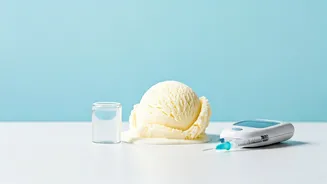Ice Cream Impact
Ice cream, a beloved dessert, has a direct impact on blood glucose levels, particularly for individuals with diabetes. The high sugar content in most ice
cream varieties can cause blood sugar spikes, which the body struggles to manage efficiently when diabetes is present. The effect of ice cream on blood sugar varies based on its composition, portion size, and the individual's metabolic rate and insulin sensitivity. Factors like fat and protein content, while potentially slowing down the absorption of sugar, also contribute to the overall calorie count, impacting weight and, consequently, diabetes management. Understanding the glycemic index (GI) and glycemic load (GL) of ice cream is essential. These metrics help assess how quickly a food raises blood sugar levels. Ice cream typically has a moderate to high GI, implying a quicker rise in blood glucose than foods with a lower GI. The combination of these factors underscores the need for careful consumption and informed choices when incorporating ice cream into a diabetic diet.
Smart Consumption Tips
To enjoy ice cream responsibly, people with diabetes need to implement several strategies. Portion control is paramount; a small serving is always better than a large one. Opting for low-sugar or sugar-free versions can significantly reduce the impact on blood sugar levels. However, it's crucial to examine the ingredients list, as some sugar-free options may contain sugar alcohols that can still affect blood sugar. Carefully monitoring carbohydrate intake is essential, as carbohydrates are the primary drivers of blood sugar elevation. It is also beneficial to eat ice cream with a meal, as the other components of the meal, such as protein and fiber, can help to slow down sugar absorption. Furthermore, regular blood sugar monitoring before and after eating ice cream provides valuable insights into how your body responds and helps fine-tune your approach. Consider exercise after eating ice cream as well. Physical activity increases insulin sensitivity and helps the body process glucose more efficiently. It’s also wise to consult a healthcare professional for personalized advice to align with your health condition.
Ingredient Awareness
The ingredients in ice cream play a significant role in determining their impact on blood sugar. Sugar, often present in high concentrations, is the primary culprit behind blood sugar spikes. It's vital to check the nutrition labels and choose ice cream with lower added sugar. Fat content affects how quickly sugar is absorbed; ice cream with more fat can slow down sugar absorption, potentially leading to a less dramatic blood sugar increase. However, the higher fat content contributes to increased calorie intake, which impacts overall health and weight management, indirectly affecting diabetes. The addition of ingredients such as fruit, nuts, and chocolate chips can also affect blood sugar. Although fruits offer some nutritional benefits, their natural sugars still contribute to the overall carbohydrate load. Nuts and chocolate chips may add some fiber and protein, but they also contain fats and can increase the calorie count. Choosing ice cream made with natural sweeteners like stevia or erythritol can lower the impact on blood sugar compared to those sweetened with sucrose or high-fructose corn syrup, but one should consume these in moderation.
Making Informed Choices
When selecting ice cream, various factors should guide people with diabetes. First and foremost, read the nutrition facts label. Pay close attention to the serving size, total carbohydrates, added sugars, and fat content. Comparing the labels of different brands or flavors enables you to make the most informed decisions. Look for brands that offer low-sugar or sugar-free options. These often use artificial sweeteners or sugar alcohols, but always consider the overall ingredient profile and your personal tolerance. Consider the GI and GL of different ice cream varieties. Lower GI and GL values indicate a slower release of glucose into the bloodstream, which is better for managing blood sugar. Choose ice cream with a good balance of macronutrients. Options that include protein and some fat alongside carbohydrates can help slow down the absorption of sugar. Be mindful of portion sizes. Even low-sugar ice cream can impact blood sugar if consumed in excess. Enjoying a small serving occasionally is more sustainable than overindulging. Always consider the context of your overall diet and health goals when making your choices.











